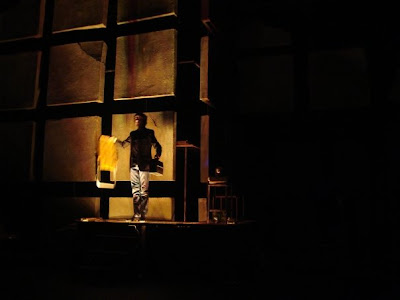The choice of this piece for Brown Theatre’s student production suggested that it would be different from the usual in the context of student-run theatre. And it was different in both its anti-naturalistic concept and its artistic quality.
The stage: concrete-like panels, interlinked with metal struts dominated the scenery. In the center stood a statue of industrial pipes from which the actors repeatedly pulled props. The pipes made allusion to Deleuze / Guattari’s non-communicating pipes but also illustrated the machine-like character of the performance; the audience was going to be part of this simultaneous machine of acting, video, music, voiceover, and text. Heiner Müller once wrote: “The myth is an aggregate, a machine, to which always new and different machines can be connected.” Accordingly, the director José Macián connected an astonishingly broad variety of artistic material to the original text: excerpts from different texts by Müller, Shakespeare’s Hamlet, quotations by Brecht, Beckett, [Erica] Jong, Marx, as well as references to classical and pop music. Moreover, Macián utilized paintings, transforming them into tableaux vivants for a theatrical medium. These connections were defined by Macián’s association, which were guided by similarities of words and contexts. Appropriately the director’s (co-author’s) image was on the back of the author’s photograph which was torn apart at the end. As the play began, two claves were struck by the director - who was located in the audience area - thus signaling what would be a systematic part of the performance: the director was integrated in the play. Even from the start, it was understood that the fourth wall between stage and spectators would be destroyed. Later, one actor walked along the front row, touching the faces of the spectators. Then, dramaturge Katrin Dettmer, left her own place in the audience in order to mount the stage as a dead philosopher throwing books at Hamlet. Finally, the actors introduced themselves to several spectators with their real names.
The piece is known for its dissolution of the concept of identity. This was realized in the Brown production by having three actors play the respective Hamlet and Ophelia parts, as well as having each actor appear later as a different modern-day person. Consequently, there were no consistent characters. Of the numerous Hamlets there was Max Posner who represented, among others, Müller and Macián (Thus the director was aware of being a privileged instance of the system, as well as the Danish prince and Müller himself in his own understanding). Sam Yambrovich, the Hamlet who wore a suit and later a tailcoat, re-appeared as a background narrator while in his underwear. Evan W. Smith, who wore a more historical costume portrayed a traditional naturalistic Hamlet, in the end speaking as Charles Manson. Alongside these Hamlets were the Ophelias, all temporarily acting as specters tensely crossing the scene. In the “Scherzo,” Tamara Del Rosso, who previously represented Rosa Luxemburg, performed a version of Ophelia’s striptease as Britney Spears in a red latex suit singing “Oops! I Did It Again”. This was controversial because according to Müller, Ophelia is a victim who revolts. But does this apply to the fallen pop diva? In order to incorporate this context, Hollis Mickey orgiastically reported some terrorist attacks by the Red Army Faction (and uncannily resembled the RAF Terrorist Gudrun Enslin). Finally, Charly E. Simpson performed as an African American Marilyn Monroe and as the Madonna. Without exception the performance of all actors in this extraordinary physical and mentally challenging staging was highly convincing.
In preparing to stage Hamletmachine, Macián and Dettmer decided to write a new translation of the text. They managed to avoid the dated and partially imprecise language of the existing translations by Carl Weber and Marc von Henning, and at the same time, amazingly succeeded in keeping the rhythm of Müller’s text. In contrast to older performances of Hamletmachine, the actors in the Brown production did not recite the text mechanically. However, several lines and paragraphs were spoken repetitiously – sometimes by one actor, sometimes alternating with another actor. Occasionally the voices swelled up to a chorus-like mosaic. In general the text was presented in various ways. It was rendered in newscast-style, babbled unemotionally, or sung. There were also moments of outrage, discomposure, and agitation, which eventually were undermined by the aforementioned dissolution of identity.
The whole staging seemed to be a mechanical process, irregularly structured by a bell and a flash, which stopped when the Ophelias placed their fingers under their eyes. At this moment, Brecht’s sentence “Don’t stare so romantically,” was revealed on the wall. The Hamletmachine stutters and some scenes reboot several times. Therefore the performance only roughly followed the original text order. Moreover, it was characterized by disillusion and irony. For example, when Horatio/Polonius played by Posner stated that he had been slain, he spoke it in a totally relaxed fashion while puffing his cigarette. Then an actor addressed the director and audience, saying that it was his voice they were about to hear on tape. Finally, one of the Hamlets said: “This play is ridiculous.”
But there was a crack in this staging. On the one hand, the machine-like, playful postmodern character lead into a destruction of the provocative qualities of the piece. On the other hand, it still referred to the outside world and did not waive a moral claim: “The main point is to overthrow all existing conditions, where humans are suppressed, abandoned, humiliated, contemptuous.” (Marx) In contrast to Müller’s text, Macián makes his Ophelias quote the complete phrase by Marx. He took this sentence seriously. After all, there was an oscillation between intensity and meaning in this performance.
In addition, Macián simultaneously destroyed and kept the dualism of sex. Both females and males, besides their own parts, performed lines and paragraphs of the different sexes. So the Hamlets speak “The woman’s Europe” first. Hence the sexes were adjusted which relativized a strong feminist position. Although relativized, it nevertheless did not destroy the power of the female roles. After a last flash and a moment of darkness, there was the motionless group of women, butcher knives in hand pointing at the audience. Before that, with a raised knife, they were presenting their wrists – still in the Ophelia paradigm. Consequently, there was a switch from self-destruction to revolutionary aggression addressing the audience. On a different level, the director’s voiceover addressed the spectator quoting Brecht: ”Let go all hope…” Furthermore, the audience’s leaving the theatre was anticipated and thereby integrated into the performance. Finally, confronted with the picture and text of the pitiless end, once again the spectator was forced to come to an understanding of this sophisticated 90-minute staging, in which theatre and society machines are reciprocally part of each other.
- Alfred Stumm (Universität Tübingen)

























































